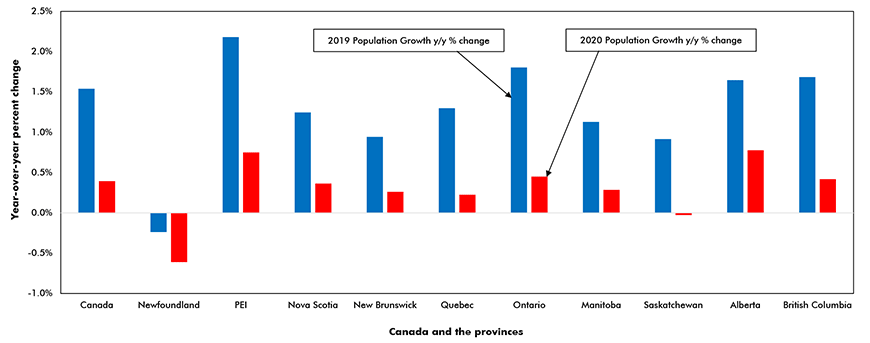Precipitous drop in net migration
After hitting a 30-year high of +1.5% in 2019, Canada’s annual population growth slowed to just +0.4% in 2020, a 104-year low, according to the latest data from Statistics Canada. Lockdowns and border closings to limit the spread of COVID-19 caused international migration, the source of over 75% of the country’s population increase since 2016, to drop from +493,000 in 2019 to +87,000 in 2019, a 22-year low.
After admitting 167,000 international migrants, almost all of whom held temporary work and study permits, the virus caused an unprecedented 86,500 of them to flee the country in 2020. Travel restrictions and quarantine regulations caused the inflow of permanent residents to fall from +290,000 in 2019 to +164,000 in 2020, a 21-year low.
COVID-19 contributed to +5.4% climb in deaths
The other contributor to the slow-down in population growth was a decline in the natural increase which results from births minus deaths. According to the Public Health Agency of Canada, 15,651 deaths due to COVID-19 pushed the total number of deaths in 2020 up by +6.8% to a record 310,000. This rise in deaths, combined with virtually no increase in births, caused the natural increase to fall from +82,000 in 2019 to +62,835 in 2020, a 98-year low.
Ontario, Quebec and B.C. bear brunt of immigration shortfalls
The negative influence of COVID-19 slowed population growth in nine of the ten provinces and caused the population of Newfoundland and Labrador to shrink by -0.6%, following a reduction of -0.2% in 2019.
Ontario, Quebec, and British Columbia, which together accepted 79% of the international migrants who arrived in Canada during 2019, were hit hardest by the precipitous drop in net international migration.
In terms of absolute numbers, Ontario (home to 39% of Canadians) saw its population increase by just +66,000 in 2020, down from +260,000 in 2019. This sharp decrease was due to a -35,000 outflow of non-permanent residents, a -30,000 decline in natural increase, a -57,000 retreat in the inflow of permanent residents, and a net outflow of -3,500 Ontarians to other provinces. As a result, the province’s population grew by just +0.5%, which was less than a third of the +1.8% gain posted in 2019 and its slowest rate of increase since 1917, more than a hundred years ago.
In percentage terms, COVID-19 hit Quebec harder than Ontario. After posting growth of +1.3% in 2019, the province’s population grew by just +0.2% in 2020, the third slowest increase in the country. The number of temporary migrants in Quebec shrank by -9,900 in 2020 following a gain of + 61,000 in 2019, while the inflow of permanent residents slowed from +33,300 to +22,500.
Also, the chronic net outflow of Quebecers to other provinces worsened from -1,500 to -1,700. The impact of 8,416 deaths due to COVID-19 (the highest among the ten provinces), together with a births’ decline of -2.8%, caused the natural increase in the province to tumble from +16,400 in 2019 to +7,300 in 2020.
British Columbia’s population growth slowed from +1.7% in 2019 to +0.4% in 2020. Like the rest of the country, the slowdown in B.C.’s population was mostly due to a sharp decline in net international migration, stemming from a -25,500 outflow of temporary residents and a -15,000 shrinkage in the inflow of permanent residents.
Also, the natural increase in British Columbia fell from +5,100 in 2019 to +1,000 as a result of a +6.8% increase in deaths, mostly due to COVID-19, and a -3% drop in number of births. The one exceptional development regarding British Columbia’s population in 2020 was that the province experienced a net inflow of +21,000 migrants from other provinces, up from +14,000 in 2019.
Immigration and natural increase to rebound after 3rd COVID wave subsides
Going forward, there is no question that the vaccine-powered light at the end of the COVID-19 tunnel is somewhat brighter than it was just three months ago. However, the recent onset of the third wave of COVID-19 and the spread of more transmissible variants of the virus, coupled with the glacial pace of increases in the supply of vaccines, suggest the impact of measures to limit its spread will continue to depress the inflow of both temporary residents seeking to work or study in Canada and individuals wishing to become permanent residents.
Looking beyond the second half of this year, Canada’s population growth will likely accelerate, driven by four factors. First, there will be an increase in the demand for labour, as reflected in the last two Statistics Canada labour market reports. Second, the fact Canada is the third most popular foreign study destination will fuel an inflow of temporary residents.
Third, the inflow of permanent residents will increase due to less restrictive travel regulations as well as thanks to recently announced measures to attract both students and youth from Hong Kong following the Chinese government’s imposition of the national security law in June of 2020. And finally, a vaccine-driven decline in deaths due to COVID-19 will contribute to a rise in the ‘natural’ population increase.
John Clinkard has over 35 years’ experience as an economist in international, national and regional research and analysis with leading financial institutions and media outlets in Canada.
Population Growth in Canada and the Provinces – 2020 vs 2019

Please click on the following link to download the PDF version of this article:
Economy Snapshot Vol. 19, Issue 7 – Expect Canada’s population to recoup lost ground in 2022 – PDF


Recent Comments
comments for this post are closed